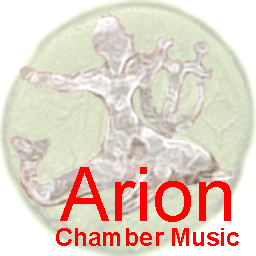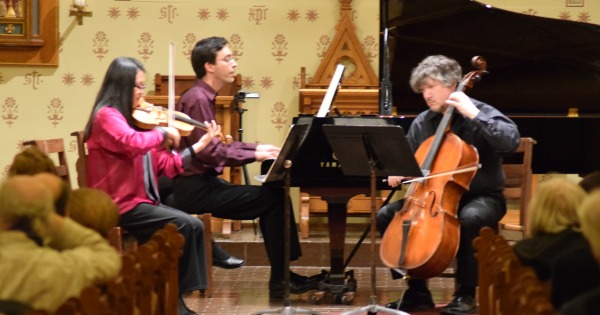 |
|
||||||
|
2019/2020 concerts Other Arion seasons |
Friday November 17, 2017 at 7:30pmProgram
Artists
Notes on the ProgramLudwig van Beethoven (1770-1827)Trio in G Major, Op. 1 No. 2Not much is known in detail about the composition of the three piano trios that Beethoven chose for publication as his Opus 1. There are signs that he hoped to use the genre to make his mark in several important ways. To begin with, the piano trios of Haydn and Mozart are, by comparison with their string quartets, relatively minor works; essentially piano sonatas with obbligato violin and a cello doubling the left hand of the piano. Beethoven’s Opus 1 trios are all four-movement works, expanding the three-movement scheme as established by Haydn and developed by Mozart -- partly for this reason, they are considerably longer than Haydn’s or Mozart’s trios, and feel more substantial -- and the string parts are both more substantial and more independent. During the period he was writing these pieces, Beethoven was touring with two of his fellow musicians from Bonn -- the cousins, cellist Bernhard and violinist Andreas Romberg, both accomplished virtuosos. This fact may have influenced Beethoven’s approach to the string writing. What seems certain is that the trios (like most of his early piano chamber music, including the sets of variations for cello and piano, and the Op. 5 cello sonatas) were intended to serve as performance vehicles for himself. He performed all three trios in Vienna on a single concert in the home of Prince Karl Lichnowsky, where Beethoven lived (initially in a small attic, later in more spacious, ground-floor rooms) during his first extended stay in the city. It was at this concert that Haydn famously recommended against including the third (C minor) trio in the published set, because he thought general audiences would find it hard to appreciate. Beethoven was inclined to attribute this pronouncement to professional jealousy; given the fact that Haydn was then internationally renowned and Beethoven all-but-unknown, this seems unlikely. But it was Haydn’s suggestion that “pupil of Haydn” should be printed beneath Beethoven’s name that aroused the young composer’s especial ire. Haydn actually seems to have been well-disposed to Beethoven; since he had recently enjoyed popular success with some of his own late piano trios, he imagined that linking the young, mostly unknown composer’s name with his own would help sales. And since Beethoven dedicated his very next set of compositions -- the three piano sonatas, Op. 2 -- to Haydn, it is unclear how deep or lasting the rancor was. Published in 1795 and dedicated to Prince Lichnowsky, the trios were a considerable success, although it would be some time yet until Beethoven’s reputation as a composer matched his acclaim as a performer. Contrary to Haydn’s prediction, the C minor trio has eclipsed the earlier two in the set -- perhaps the G major in particular. As the C minor trio with its Sturm und Drang, early-Romantic tempestuousness represents so much of what we have come to think of as quintessentially ‘Beethovenian’, the G major highlights more genial and playful aspects that, in later works, are mostly relegated to scherzi. In this way, Op. 1 #2 has real potential to surprise listeners. There is a freshness to the work, not entirely owing to the fact that it is less often performed. Formal and structural details play some part in this. The long adagio introduction and the harmonic instability with which the ensuing allegro vivace of the first movement begins (in which more than twenty measures pass before the theme finds its home securely in the tonic); third-related key areas that take us to E major in the largo con espressione and to B minor in the trio section of the scherzo. (The beginning of this scherzo must be the very first time a movement in a piano trio begins with the cello alone.) A comical fugato opening and manipulations of tempo figure importantly in the sparkling presto Finale. Antonin Dvorak (1841-1904)Trio in F Minor, Op. 65It is an irony, as well as a source of lasting pride to New Yorkers, that Antonin Dvorak -- that most distinctively Bohemian composer and poster-boy for late 19th century Czech nationalism -- should have written two of his most acclaimed mature compositions while resident here in New York City. Both his Symphony From the New World and his monumental Cello Concerto date from his tenure as Director of the National Conservatory of Music. (The F Major “American” Quartet was also written in this country, during a summer holiday in the Bohemian Czech community of Spillville, Iowa). In 1892, Dvorak was recruited to become the Director of the National Conservatory of Music, which had recently been founded on West 17th St. in Manhattan by the remarkable arts patroness Jeanette Meyers Thurber, daughter of a Danish immigrant violinist and wife of a successful wholesale grocer. Her ultimate vision -- for a publicly-funded institution to foster and promote the development of American music and musicians -- was never realized. Although legislation to that effect passed through Congress in 1891 and was signed by then-President Benjamin Harrison (another in the venerable line of popular-vote-losing Republican presidents) no money was ever allocated. As a result, the school (which by 1900 had about 3,000 students) was funded almost entirely out of Ms. Thurber’s private resources. (The fact that women, African Americans, and individuals with physical disabilities were all actively recruited as students -- as much as Ms. Thurber’s not-quite-top-drawer social status -- seems to have discouraged much additional private patronage from the city’s bon ton.) Having declined the position several times, Dvorak was finally attracted by the offer of a $15,000 annual salary (lavish by the standards of the late 19th century and many times the equivalent of his earnings in Europe, where he was a well-established composer and beginning to be a sought-after conductor). Before he had completed his first year in the position, the effects of the financial panic of 1893 forced Ms. Thurber to cut his salary nearly in half, and its remittance became erratic. Added to Dvorak’s distaste for big-city life and homesickness for his native Bohemia, this failure to honor the terms of his contract made it easy for him to decide to return to Europe. The Trio in F minor, Op. 65, dates from an earlier period in Dvorak’s life, when he was making conscious efforts to develop a more ‘international’ (in the context of the time, German) style -- partly from a desire to reach a wider audience, but possibly also as the result of developing anti-Czech political sentiments (that tended to bleed into concert halls) in Austria in the 1880s. He received vigorous and sustained assistance from Johannes Brahms, who introduced Dvorak to his own publisher, Simrock, resulting in the publication of the Moravian Duets, Op, 20 for two voices and piano, which were Dvorak’s first ‘hit’ as a composer, and were speedily followed by the first volume of his wildly successful Slavonic Dances for piano, four-hands (later orchestrated). In the same way that the Slavonic Dances were modelled on Brahms’s popular (and profitable) Hungarian Dances, the F minor trio is clearly heavily influenced by Brahms’s developed chamber music style. Certainly, the opening bars of the trio bear much more than a passing resemblance to the beginning of Brahms’s F minor piano quintet (and the keys are identical). But what Dvorak achieves in the work as a whole is a synthesis of his distinctive Bohemian sensibility with the scope and structural rigor of the Germanic composers he admired -- Mozart, Beethoven, and Brahms himself. Partly as a result of this -- and partly no doubt because it was composed not long after the death of Dvorak’s mother -- the F minor trio has a depth of expressive intensity only occasionally hinted at by the later and much flimsier “Dumky”. Program Notes © Robert La Rue, 2017 |
